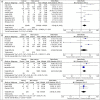This is a preprint.
A systematic review and meta-analysis of cancer patients affected by a novel coronavirus
- PMID: 32511470
- PMCID: PMC7265691
- DOI: 10.1101/2020.05.27.20115303
A systematic review and meta-analysis of cancer patients affected by a novel coronavirus
Update in
-
A Systematic Review and Meta-Analysis of Cancer Patients Affected by a Novel Coronavirus.JNCI Cancer Spectr. 2021 Feb 24;5(2):pkaa102. doi: 10.1093/jncics/pkaa102. eCollection 2021 Apr. JNCI Cancer Spectr. 2021. PMID: 33875976 Free PMC article.
Abstract
Background: Cancer patients with COVID-19 disease have been reported to have double the case fatality rate of the general population.
Materials and methods: A systematic search of PubMed/MEDLINE, Embase, Cochrane Central, Google Scholar, and MedRxiv was done for studies on cancer patients with COVID-19. Pooled proportions were calculated for categorical variables. Odds ratio and forest plots were constructed for both primary and secondary outcomes. The random-effects model was used to account for heterogeneity between studies.
Results: This systematic review of 31 studies and meta-analysis of 181,323 patients from 26 studies involving 23,736 cancer patients is the largest meta-analysis to the best of our knowledge assessing outcomes in cancer patients affected by COVID-19. Our meta-analysis shows that cancer patients with COVID-19 have a higher likelihood of death (odds ratio, OR 2.54), which was largely driven by mortality among patients in China. Cancer patients were more likely to be intubated, although ICU admission rates were not statistically significant. Among cancer subtypes, the mortality was highest in hematological malignancies (OR 2.43) followed by lung cancer (OR 1.8). There was no association between receipt of a particular type of oncologic therapy and mortality. Our study showed that cancer patients affected by COVID-19 are a decade older than the normal population and have a higher proportion of co-morbidities. There was insufficient data to assess the association of COVID-directed therapy and survival outcomes in cancer patients. Despite the heterogeneity of studies and inconsistencies in reported variables and outcomes, these data could guide clinical practice and oncologic care during this unprecedented global health pandemic.
Conclusion: Cancer patients with COVID-19 disease are at increased risk of mortality and morbidity. A more nuanced understanding of the interaction between cancer-directed therapies and COVID-19-directed therapies is needed. This will require uniform prospective recording of data, possibly in multi-institutional registry databases.
Keywords: COVID-19; cancer; chemotherapy; meta-analysis; radiotherapy.
Conflict of interest statement
The authors do not report any conflict of interest relevant to the information in this manuscript
Figures




References
-
- Coronavirus 2019-nCoV, CSSE. Coronavirus 2019-nCoV Global Cases by Johns Hopkins CSSE. (Available from: https://gisanddata.maps.arcgis.com/apps/opsdashboard/index. html#/bda7594740fd40299423467b48e9ecf6)
-
- World Health Organization International Agency for Research on Cancer (IARC). GLOBOCAN 2018: estimated cancer incidence, mortality and prevalence worldwide in 2018. [homepage on the internet]; 2020. [cited 2020 May 23]. Available from: https://gco.iarc.fr/today/data/factsheets/cancers/39-All-cancers-fact-sh....
-
- https://canceratlas.cancer.org/the-burden/cancer-survivorship/. accessed on May 23 2020.
-
- Gao Y, Liu M, Shi S et al. Cancer is associated with the severity and mortality of patients with COVID-19: a systematic review and meta-analysis. 2020; 2020.2005.2001.20087031.
Publication types
LinkOut - more resources
Full Text Sources
